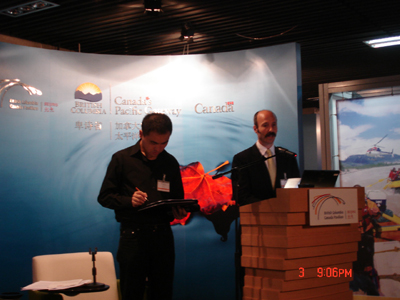
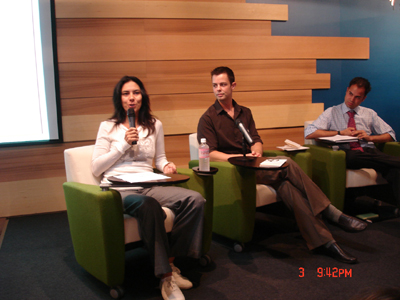
Gail Maurice,Adam Garnet Jones,Arjun Vinodrai
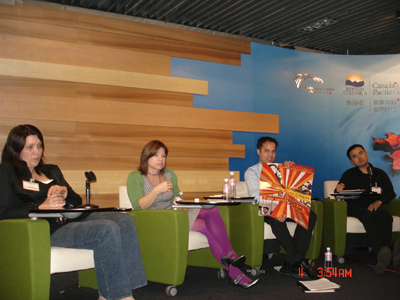
Loretta Todd,Laura Milliken,Arjun Vinodrai
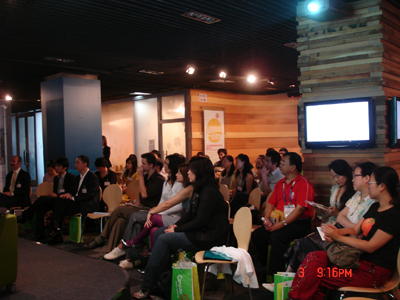
Contemporary Perspectives on Canadian Aboriginal Film and Culture
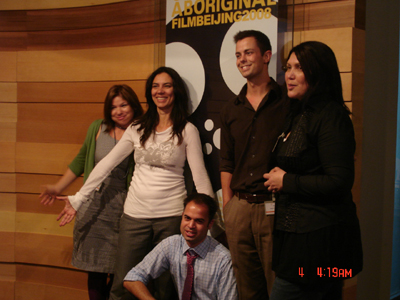
Canadian Aboriginal Film Directors
A special event, Contemporary Perspectives on Canadian Aboriginal Film and Culture: A Selection of Contemporary Film and Video from Canada’s Aboriginal Communities, which was organized by the Canadian Embassy of China, has held at the BC-Canada Pavilion(BCCP) in the Beijing Planning Exhibition Hall in Beijing, China on 4th of September, 2008. On behalf of the Embassy of Canada in China, Mr. Patrice Cousineau, the Counsellor and Head for Public Affairs, addressed the opening remarks. There are more than 70 participants from both Canada and China attended the event, among which, 4 young Aboriginal filmmakers from Canada. This event was chaired by Mr. Arjun Vinodrai from the Department of Canadian Heritage.
In his opening remarks, Mr. Cousineau said that the BCCP has been a point of convergence in Beijing for Chinese and Canadian cultural actors, educators, academics, business-people and more over the last 4 months. I am confident that the ties created through these exchanges will nurture enduring cooperation and friendships. He pointed out that Canada prides itself on being a country that is extremely diverse, both in terms of physical and human geography. Through trials and errors during our history, we have learned to celebrate multiculturalism, to value, maintain and embrace cultural diversity. This has required compromise and dialogue. Canadians have understood that if we diminish the cultural heritage of our people, our country as a whole is diminished. Yet when we embrace the same heritage, our country as a whole is strengthened. Individuals, confident in their history, their uniqueness, and in their place in society are those best equipped to build their communities and realize their goals. However, many challenges remain. Issues relating to loss of cultural identity in a contemporary setting, lack of opportunities and poverty, among other. The Canadian government is working with Aboriginal peoples to ensure they have the tools they need to take charge of their own affairs and to foster self-reliant individuals and communities. For example, through the Urban Aboriginal Strategy in 2007, $68.5 million were set aside on a five-year initiative to help respond to the needs of Aboriginal peoples living in key urban centres and ensure that Aboriginal Canadians have greater access to the skills and experiences they need to succeed in an urban setting. The Government has also taken action to improve education for Aboriginal Canadians. In British Columbia, an agreement was signed in 2006 that enables First Nations to assume meaningful control over areas such as curriculum, standards, school and teacher certification. Similar approaches to improving education outcomes in other provinces are under way.
Mr. Cousineau emphasized that today’s screenings provide insights into a number of realities of contemporary Aboriginal people. I hope this will be an opportunity to reflect on a few of these issues but also to enjoy true expressions of Aboriginal creativity. He hoped that through the film screenings and exchanges, some important questions which aboriginal and minority populations in Canada and in China face will be discussed in a spirit of openness and friendship, so that we may learn from our respective situations. Questions revolving around the challenges that urbanization presents to the maintenance of cultural identity, and the implications of loss of language and culture.
In the one-day event, 4 Canadian Aboriginal film directors, including Mr. Adam Garnet Jones, Ms. Gail Maurice, Ms. Laura Milliken and Ms. Loretta Todd, showcased and discussed with Chinese counterparts. 6 Aboriginal films, such as Cloud-breaker, Smudge, The Peoples Go on, I am Not the Indian You Had in Mind, Urban Elder and Writing the Hand, exhibited and dubuted to Chinese audience, which represented a range of contemporary Aboriginal experiences and resonate with an oral storytelling tradition that is thousands of years old. They use a variety of aesthetic styles and conceptual approaches to tell unique stories that reflect the diverse languages, cultures and experiences of Canada’s Aboriginal peoples. It is studied that these are the stories of the descendants of those who suffered drastic change, including loss of culture and language, after contact with Europeans, which began some 500 years ago. Much has been done to redress the injustices of the past, but this process is far from over. Our current post-colonial context provides fertile ground for a talented new generation of Aboriginal filmmakers empowered to tell their own stories, often with a wry sense of humour. These young filmmakers draw upon ancestral memory, evolving technologies, and the conceptual and aesthetic influences of global culture to reflect the myriad of contemporary realities of Canada’s original people. This program offered a glimpse into the ground-breaking new wave of Aboriginal cinema.
Over 70 participants attended this event, 10 of which came from Canada including 4 Canadian filmmakers, others from the Department of Canadian Heritage, and the Canadian Embassy in Beijing. Chinese attendees came from the Chinese National Academy of Social Sciences, Beijing Normal University, Tsinghua Universiy, Central University for Nationalities, and Communication University of China, etc.
(Provided by ZHANG Xiaomin and DU Fachun, CASS)